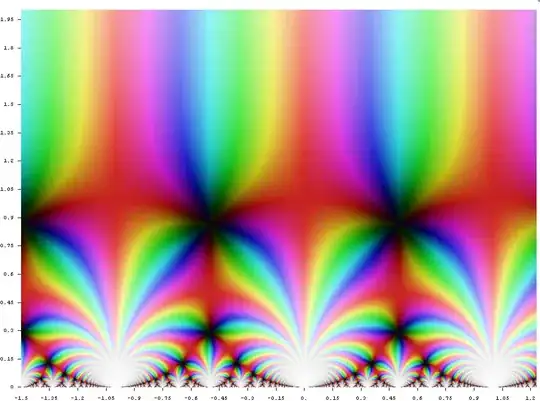I will use the shorthand $\zeta_n = \exp(2\pi\mathrm{i}/n)$.
Regarding correctness, you may need to explain why passing from $J^{-1}$
to $\lambda^{-1}$ does not change the number of preimages.
To that end, it should be mentioned explicitly that for a given
$w\in\mathbb{C}\setminus\{0,1\}$ the function $\tau\mapsto\lambda(\tau)-w$
has exactly one simple zero in the fundamental region you have described,
if appropriate care is taken with inclusion or exclusion of boundary points.
This is a specialty of $\lambda$, it is not implied by just mentioning the
fundamental region.
I do not know whether Ahlfors's text contains a proof of this, but
the evergreen reference
- Whittaker & Watson (1915), A Course of Modern Analysis, 2nd edition,
Merchant Books, ISBN 1-60386-121-1
has a nice proof of this at about page 474, based on a contour integral.
As for solving $\lambda(\tau)=w$, note that
$$\begin{align}
\lambda(\tau+1) = \lambda(\tau-1) &=
\frac{\lambda(\tau)}{\lambda(\tau)-1}
\\ \lambda\left(\frac{-1}{\tau}\right) &= 1-\lambda(\tau)
\end{align}$$
(I suppose that Ahlfors covers that.)
Now $\tau=\mathrm{i}$ is fixed by $\tau\mapsto\frac{-1}{\tau}$, therefore
$$\begin{align}
\lambda(\mathrm{i}) &=
\lambda\left(\frac{-1}{\mathrm{i}}\right) =
1-\lambda(\mathrm{i})
\\\therefore\quad
\lambda(\mathrm{i}) &= \frac{1}{2}
\\ \lambda(\mathrm{i}+1) &=
\frac{\lambda(\mathrm{i})}{\lambda(\mathrm{i})-1} = -1
\\ \lambda\left(\frac{\mathrm{i}+1}{2}\right) &=
\lambda\left(\frac{-1}{\mathrm{i}-1}\right) =
1 - \lambda(\mathrm{i}-1) = 2
\end{align}$$
Similarly, $\tau=\zeta_3$ is fixed by $\tau\mapsto\frac{-1}{\tau+1}$, therefore
$$\begin{align}
\lambda(\zeta_3) = \lambda\left(\frac{-1}{\zeta_3+1}\right) &=
1 - \lambda(\zeta_3+1) =
1 - \frac{\lambda(\zeta_3)}{\lambda(\zeta_3)-1} =
\frac{-1}{\lambda(\zeta_3) - 1}
\\\therefore\quad
\lambda(\zeta_3) \left(\lambda(\zeta_3)-1\right) + 1 &= 0
\tag{*}
\\\therefore\quad
\lambda(\zeta_3) \in\left\{\zeta_6, \zeta_{-6}\right\}
\end{align}$$
In a similar manner, we can find that $\lambda(\zeta_6)$
fulfills the same polynomial equation $(*)$. This is all we need.
However, in case you want to disambiguate $\lambda(\zeta_3)$
and $\lambda(\zeta_6)$, a useful approach is to work out that
$\Im\lambda(\tau)>0$ in the right half of $\lambda's$ fundamental domain
(where $\Re\tau>0$) and $\Im\lambda(\tau)<0$ in the left half.
I will omit that here and just remark that
$$\begin{align}
\lambda(\zeta_3) &= \zeta_{-6}
\\ \lambda(\zeta_6) &= \lambda\left(\frac{-1}{\zeta_3}\right) =
1 - \lambda(\zeta_3) = \zeta_6
\end{align}$$
as you have speculated.
It should be noted that the locations of the preimages are consistent
with the symmetries of $J(\tau)$ with respect to the full modular group:
$$J(\tau+1) = J(\tau) = J\left(\frac{-1}{\tau}\right)$$
The result is that $J(\tau)$ has a triple zero at every
$\tau=\frac{a\zeta_6+b}{c\zeta_6+d}$ with
$\begin{pmatrix}a&b\\c&d\end{pmatrix}\in\operatorname{SL}(2,\mathbb{Z})$,
and that $J(\tau)=1$ has a double root at every
$\tau=\frac{a\mathrm{i}+b}{c\mathrm{i}+d}$ with
$\begin{pmatrix}a&b\\c&d\end{pmatrix}\in\operatorname{SL}(2,\mathbb{Z})$.
Keeping in mind that $ad-bc=1$, you can rewrite those formulae for $\tau$ as
$$\begin{align}
\frac{a\mathrm{i}+b}{c\mathrm{i}+d} &=
\frac{ac+bd+\mathrm{i}}{c^2+d^2} =
\frac{u + \mathrm{i}}{N}
\\ &\quad\text{where}\quad
N,u\in\mathbb{Z};\quad N>0;\quad N\mid (u^2+1)
\\ \frac{a\zeta_6+b}{c\zeta_6+d} &=
\frac{ac+bc+bd+\zeta_6}{c^2+cd+d^2} =
\frac{u + \zeta_6}{N}
\\ &\quad\text{where}\quad
N,u\in\mathbb{Z};\quad N>0;\quad N\mid (u^2+u+1)
\end{align}$$
Conversely, it can be shown, essentially by an induction that traces the
steps of the extended euclidean algorithm, that for every choice of
$N,u\in\mathbb{Z}$ fulfilling the stated conditions, a suitable
$\begin{pmatrix}a&b\\c&d\end{pmatrix}\in\operatorname{SL}(2,\mathbb{Z})$
can be determined. I suspect that you are already satisfied with
the transform-based representation, so I just mention this as a sidenote.
Feel free to ask for additional details if you are interested and get stuck.
I cannot resist mentioning a couple of well-known connections.
Simple algebraic manipulations reveal that
the locations $\tau$ where $J(\tau)=0$ resp. $J(\tau)=1$
can as well be identified with the (simple) zeros of
the Eisenstein series
$$\begin{align}
g_2 &= -4 (e_1 e_2 + e_1 e_3 + e_2 e_3)
\\\text{resp.}\quad
g_3 &= 4 e_1 e_2 e_3
\end{align}$$
or of the corresponding normalized series
$\operatorname{E}_4$ resp. $\operatorname{E}_6$.
The zeros of $\operatorname{E}_6$ can also be recognized as the tangent points of the Ford circles, if you include the line $\Im\tau=1$ as an extra "circle".
To see that, note that both sets of points are invariant under
transformations of the full modular group, and coincede in the
full modular group's fundamental domain.
